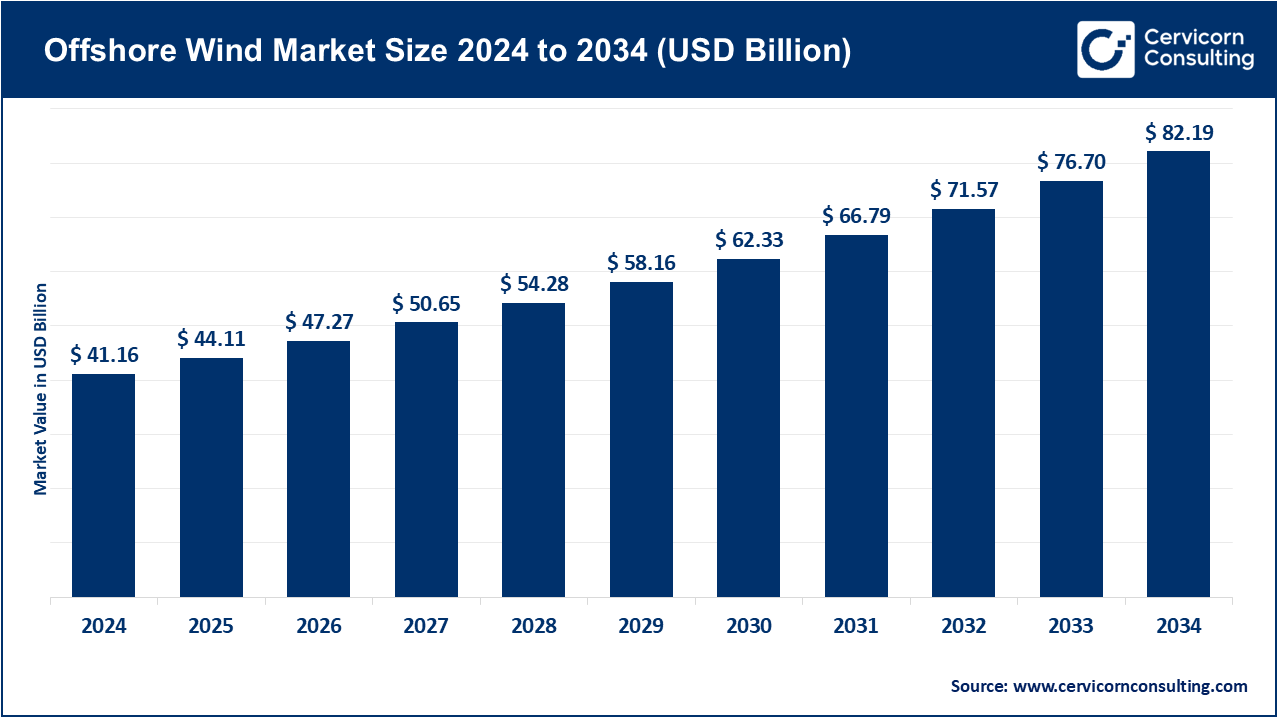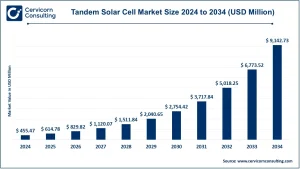Market Overview
The offshore wind market is witnessing significant growth as countries accelerate their transition to renewable energy. The global offshore wind market was valued at around USD 44.11 billion in 2024 and is expected to reach approximately USD 82.19 billion by 2034, registering a CAGR of 7.16% during the forecast period. This expansion is fueled by increasing worldwide electricity demand, supportive government policies, and the drive for decarbonization. Utilizing both fixed-bottom and floating foundation technologies, offshore wind harnesses stronger and more consistent wind speeds at sea, enabling the generation of large-scale clean electricity directly near coastal consumption centers.
📌 Get a Free Sample: Cervicorn Consulting
Key Market Trends
1. Growth of Floating Offshore Wind Farms
Advanced floating foundation designs, such as semi-submersible and spar-buoy systems, are opening access to deep-water locations beyond 60 meters. This trend expands the geographic reach of offshore projects, particularly in areas like Japan, Scotland, and the U.S. West Coast. Floating turbines are also increasingly being paired with hybrid applications, such as offshore hydrogen production, to enhance energy versatility.
2. Integration of AI and Predictive Maintenance
The deployment of AI-driven digital twins, predictive blade monitoring, and autonomous inspection systems (drones and AUVs) is transforming operational efficiency. These technologies reduce downtime, extend turbine lifespan, and optimize maintenance schedules, ultimately improving returns on investment and bolstering investor confidence
3. Localization of Supply Chains
Governments worldwide are encouraging domestic production of turbine components—blades, nacelles, and monopiles—to boost employment and reduce logistics and tariff costs. This policy support is leading to the development of new industrial clusters, upgraded port infrastructure, and specialized vessel fleets across Europe, Asia-Pacific, and North America.
4. Hybrid Offshore Wind-to-Hydrogen Projects
Offshore wind projects are increasingly being coupled with hydrogen electrolyzers to enable energy storage and sector integration. These hybrid systems address intermittency challenges, create new revenue streams, and support national hydrogen production goals.
Market Drivers
- Rising Energy Demand: Global electricity consumption is increasing, and offshore wind offers a scalable, sustainable solution to meet this demand.
- Government Initiatives and Incentives: Policies including Contracts for Difference (CfDs), tax incentives, and port infrastructure investments are crucial in expediting project development.
- Technological Advancements: Deployment of large turbines (15–20+ MW), floating foundations, and high-capacity subsea cables enhances project feasibility and reduces costs.
- Decarbonization & Energy Security Goals: Offshore wind supports national climate objectives while reducing dependence on imported fossil fuels.
- Institutional Investment: Stable, long-term financing from infrastructure funds and utilities is driving market growth due to predictable returns compared to traditional energy sources.
Impact of Trends and Drivers
Regional Impact:
- Europe continues to lead, holding nearly half of the global market share, supported by mature supply chains and ambitious renewable energy targets.
- Asia-Pacific, particularly China, is experiencing rapid growth driven by government-backed industrial strategies.
- North America is an emerging market, with federal and state incentives, offshore leasing programs, and tax benefits encouraging large-scale development.
Segmental Impact:
- Turbine Technology: Increasing turbine size and efficiency lowers the levelized cost of energy (LCOE), improving project viability.
- Floating Offshore Wind: Expands potential in countries with limited shallow coastal waters.
- Hybrid Energy Models: Integration with hydrogen production and desalination systems diversifies applications and revenue streams.
Challenges & Opportunities
Challenges: The market faces high initial capital requirements, potential supply chain bottlenecks, and complex regulatory environments.
Opportunities: The adoption of floating offshore platforms, integration with hydrogen, and establishment of local supply chains present significant growth potential.
Future Outlook
The offshore wind market is poised for continued expansion, driven by technological innovation, scalability of floating wind, and integration with broader energy systems such as hydrogen and digital grids. Europe and Asia-Pacific are expected to maintain leadership due to supportive policies and established industrial ecosystems, while North America is emerging as a significant contributor to global capacity growth in the next decade.
📌 Contact Us for a Detailed Overview: Cervicorn Consulting


